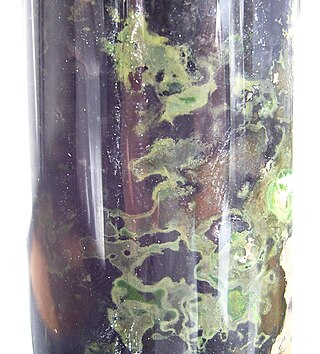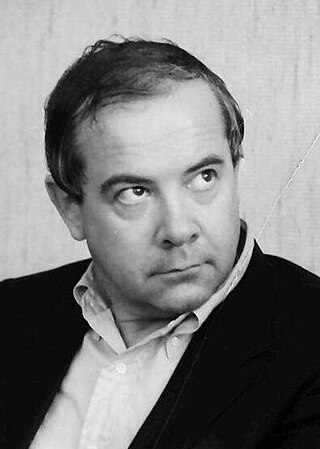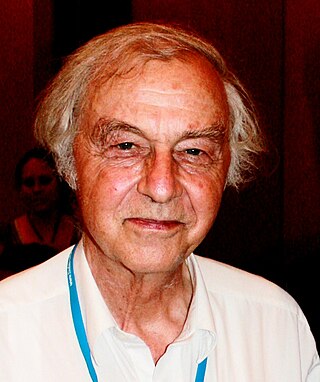Related Research Articles

Photosynthesis is a system of biological processes by which photosynthetic organisms, such as most plants, algae, and cyanobacteria, convert light energy, typically from sunlight, into the chemical energy necessary to fuel their metabolism. Photosynthesis usually refers to oxygenic photosynthesis, a process that produces oxygen.
Photosynthetic organisms store the chemical energy so produced within intracellular organic compounds like sugars, glycogen, cellulose and starches. To use this stored chemical energy, an organism's cells metabolize the organic compounds through cellular respiration. Photosynthesis plays a critical role in producing and maintaining the oxygen content of the Earth's atmosphere, and it supplies most of the biological energy necessary for complex life on Earth.

The green sulfur bacteria are a phylum, Chlorobiota, of obligately anaerobic photoautotrophic bacteria that metabolize sulfur.

The Technical University of Munich is a public research university in Munich, Bavaria, Germany. It specializes in engineering, technology, medicine, and applied and natural sciences.

Johann Deisenhofer is a German biochemist who, along with Hartmut Michel and Robert Huber, received the Nobel Prize for Chemistry in 1988 for their determination of the first crystal structure of an integral membrane protein, a membrane-bound complex of proteins and co-factors that is essential to photosynthesis.

Photosystems are functional and structural units of protein complexes involved in photosynthesis. Together they carry out the primary photochemistry of photosynthesis: the absorption of light and the transfer of energy and electrons. Photosystems are found in the thylakoid membranes of plants, algae, and cyanobacteria. These membranes are located inside the chloroplasts of plants and algae, and in the cytoplasmic membrane of photosynthetic bacteria. There are two kinds of photosystems: PSI and PSII.

Photosystem I is one of two photosystems in the photosynthetic light reactions of algae, plants, and cyanobacteria. Photosystem I is an integral membrane protein complex that uses light energy to catalyze the transfer of electrons across the thylakoid membrane from plastocyanin to ferredoxin. Ultimately, the electrons that are transferred by Photosystem I are used to produce the moderate-energy hydrogen carrier NADPH. The photon energy absorbed by Photosystem I also produces a proton-motive force that is used to generate ATP. PSI is composed of more than 110 cofactors, significantly more than Photosystem II.

Robert Huber is a German biochemist and Nobel laureate. known for his work crystallizing an intramembrane protein important in photosynthesis and subsequently applying X-ray crystallography to elucidate the protein's structure.

Hartmut Michel is a German biochemist, who received the 1988 Nobel Prize in Chemistry for determination of the first crystal structure of an integral membrane protein, a membrane-bound complex of proteins and co-factors that is essential to photosynthesis.

Purple bacteria or purple photosynthetic bacteria are Gram-negative proteobacteria that are phototrophic, capable of producing their own food via photosynthesis. They are pigmented with bacteriochlorophyll a or b, together with various carotenoids, which give them colours ranging between purple, red, brown, and orange. They may be divided into two groups – purple sulfur bacteria and purple non-sulfur bacteria. Purple bacteria are anoxygenic phototrophs widely spread in nature, but especially in aquatic environments, where there are anoxic conditions that favor the synthesis of their pigments.
Photodissociation, photolysis, photodecomposition, or photofragmentation is a chemical reaction in which molecules of a chemical compound are broken down by absorption of light or photons. It is defined as the interaction of one or more photons with one target molecule that dissociates into two fragments.
A photosynthetic reaction center is a complex of several proteins, pigments, and other co-factors that together execute the primary energy conversion reactions of photosynthesis. Molecular excitations, either originating directly from sunlight or transferred as excitation energy via light-harvesting antenna systems, give rise to electron transfer reactions along the path of a series of protein-bound co-factors. These co-factors are light-absorbing molecules (also named chromophores or pigments) such as chlorophyll and pheophytin, as well as quinones. The energy of the photon is used to excite an electron of a pigment. The free energy created is then used, via a chain of nearby electron acceptors, for a transfer of hydrogen atoms (as protons and electrons) from H2O or hydrogen sulfide towards carbon dioxide, eventually producing glucose. These electron transfer steps ultimately result in the conversion of the energy of photons to chemical energy.

A chlorosome is a photosynthetic antenna complex found in green sulfur bacteria (GSB) and many green non-sulfur bacteria (GNsB), together known as green bacteria. They differ from other antenna complexes by their large size and lack of protein matrix supporting the photosynthetic pigments. Green sulfur bacteria are a group of organisms that generally live in extremely low-light environments, such as at depths of 100 metres in the Black Sea. The ability to capture light energy and rapidly deliver it to where it needs to go is essential to these bacteria, some of which see only a few photons of light per chlorophyll per day. To achieve this, the bacteria contain chlorosome structures, which contain up to 250,000 chlorophyll molecules. Chlorosomes are ellipsoidal bodies, in GSB their length varies from 100 to 200 nm, width of 50-100 nm and height of 15 – 30 nm, in GNsB the chlorosomes are somewhat smaller.
Spin chemistry is a sub-field of chemistry positioned at the intersection of chemical kinetics, photochemistry, magnetic resonance and free radical chemistry, that deals with magnetic and spin effects in chemical reactions. Spin chemistry concerns phenomena such as chemically induced dynamic nuclear polarization (CIDNP), chemically induced electron polarization (CIDEP), magnetic isotope effects in chemical reactions, and it is hypothesized to be key in the underlying mechanism for avian magnetoreception and consciousness.
Quantum biology is the study of applications of quantum mechanics and theoretical chemistry to aspects of biology that cannot be accurately described by the classical laws of physics. An understanding of fundamental quantum interactions is important because they determine the properties of the next level of organization in biological systems.
Heinz Gerischer was a German chemist who specialized in electrochemistry. He was the thesis advisor of future Nobel laureate Gerhard Ertl.

Photosynthetic reaction centre proteins are main protein components of photosynthetic reaction centres (RCs) of bacteria and plants. They are transmembrane proteins embedded in the chloroplast thylakoid or bacterial cell membrane.

Light-dependent reactions are certain photochemical reactions involved in photosynthesis, the main process by which plants acquire energy. There are two light dependent reactions: the first occurs at photosystem II (PSII) and the second occurs at photosystem I (PSI).

Marion Charlotte Thurnauer is an American chemist at Argonne National Laboratory (Argonne). She was the first woman director of the Chemistry Division (CHM) and the first woman division director in the Physical Sciences Directorate at Argonne. She is an Argonne Distinguished Fellow Emeritus in the Chemical Sciences and Engineering Division and has received numerous awards for her work in chemistry and her support of women in science.
Klaus Schulten was a German-American computational biophysicist and the Swanlund Professor of Physics at the University of Illinois at Urbana-Champaign. Schulten used supercomputing techniques to apply theoretical physics to the fields of biomedicine and bioengineering and dynamically model living systems. His mathematical, theoretical, and technological innovations led to key discoveries about the motion of biological cells, sensory processes in vision, animal navigation, light energy harvesting in photosynthesis, and learning in neural networks.

Wolfgang Lubitz is a German chemist and biophysicist. He is currently a director emeritus at the Max Planck Institute for Chemical Energy Conversion. He is well known for his work on bacterial photosynthetic reaction centres, hydrogenase enzymes, and the oxygen-evolving complex using a variety of biophysical techniques. He has been recognized by a Festschrift for his contributions to electron paramagnetic resonance (EPR) and its applications to chemical and biological systems.
References
- 1 2 3 4 5 "Maria-Elisabeth Michel-Beyerle (English)". Technische Universität München. Archived from the original on 29 June 2016. Retrieved 12 January 2016.
- 1 2 3 4 "Maria-Elisabeth Michel-Beyerle (German)". Technische Universität München. Retrieved 12 January 2016.
- 1 2 "Prof. Dr. Maria-Elisabeth MICHEL-BEYERLE". TUM Create. Archived from the original on 30 June 2016. Retrieved 12 January 2016.
- ↑ "Home". Control of assembly and charge transport dynamics of immobilized DNA. Archived from the original on 2016-01-11. Retrieved 2016-01-12.
- ↑ "Regional Focus – APA Singapore" (PDF). Newsletter April 2012. The Asian and Oceanian Photochemistry Association. Retrieved 12 January 2016.
- 1 2 3 "Prof Maria-Elisabeth Michel-Beyerle". Nanyang Technological University. Retrieved 12 January 2016.
- ↑ Atherton, N. M.; Davies, M.J.; Gilbert, B.C. (1998). Electron Paramagnetic Resonance: A review of the recent literature to 1997. Cambridge, UK: Royal Society of Chemistry. p. 259. ISBN 978-0-85404-305-7 . Retrieved 13 January 2016.
- ↑ Bube, W.; Haberkorn, R.; Michel-Beyerle, M. E. (September 1978). "Magnetic field and isotope effects induced by hyperfine interaction in a steady state photochemical experiment". Journal of the American Chemical Society. 100 (19): 5993–5995. doi:10.1021/ja00487a002.
- ↑ Lersch, W.; Michel-Beyerle, M.E. (July 1983). "Magnetic field effects on the recombination of radical ions in reaction centers of photosynthetic bacteria". Chemical Physics. 78 (1): 115–126. Bibcode:1983CP.....78..115L. doi:10.1016/0301-0104(83)87012-8.
- ↑ Michel-Beyerle, Maria-Elisabeth, ed. (2012). The Reaction center of photosynthetic bacteria : structure and dynamics. [S.l.]: Springer Science & Business Media. ISBN 978-3-642-64723-9.
- ↑ Govindjee, J. Thomas Beatty; Gest, H.; Allen, J.F. (2005). Discoveries in Photosynthesis. Netherlands: Springer. p. 219. ISBN 978-1-4020-3323-0 . Retrieved 8 January 2016.
- ↑ Deisenhofer, J.; Michel, H. (December 8, 1988). "Nobel lecture. The photosynthetic reaction centre from the purple bacterium Rhodopseudomonas viridis" (PDF). Nobel Prize.org.
- ↑ Michel-Beyerle, M. E.; Plato, M.; Deisenhofer, J.; Michel, H.; Bixon, M.; Jortner, J. (January 20, 1988). "Unidirectionality of charge separation in reaction centers of photosynthetic bacteria". Biochimica et Biophysica Acta (BBA) - Bioenergetics. 932 (1): 52–70. doi:10.1016/0005-2728(88)90139-9.
- ↑ "MICHEL- BEYERLE, Maria-Elisabeth Professor". Nanyang Technological University. Retrieved 13 January 2016.
- ↑ Gerischer,H.; Michel-Beyerle,M.; Rebentrost, E.; Tributsch, H. (1968). "Sensitization of Charge-Injection into Semiconductors with Large Band Gap". Electrochimica Acta. 13 (6): 1509–1515. doi:10.1016/0013-4686(68)80076-3.
- ↑ Jung, Gregor; Wiehler, Jens; Zumbusch, Andreas (March 2005). "The Photophysics of Green Fluorescent Protein: Influence of the Key Amino Acids at Positions 65, 203, and 222". Biophysical Journal. 88 (3): 1932–1947. Bibcode:2005BpJ....88.1932J. doi:10.1529/biophysj.104.044412. PMC 1305246 . PMID 15613627.
- ↑ "Search for Maria-Elisabeth Michel-Beyerle". Bayerischer Verdienstorden. Retrieved 12 January 2016.
- ↑ Heinrichsen, Dieter (January 20, 2006). "Höchste Auszeichnung für TU-Chemikerin: Maria Elisabeth Michel-Beyerle erhält Maximiliansorden". IDW Informationsdienst Wissenschaft.
- ↑ "Bayerische Verfassungsmedaille". MEMIM Encyclopedia. Archived from the original on 4 March 2016. Retrieved 11 January 2016.
- ↑ "Heinz Maier-Leibnitz-Medaille". Technische Universität München. Retrieved 12 January 2016.